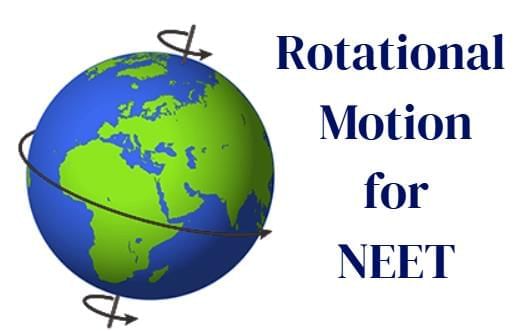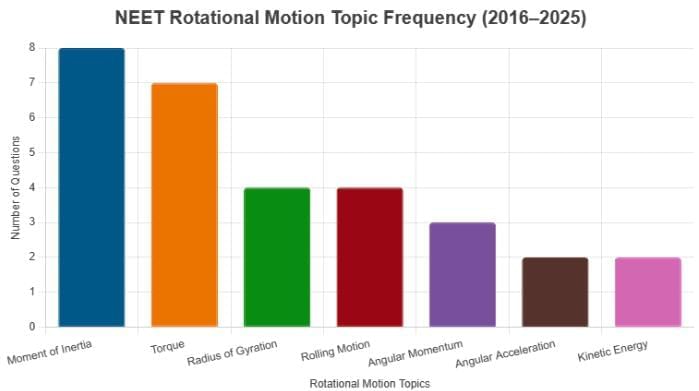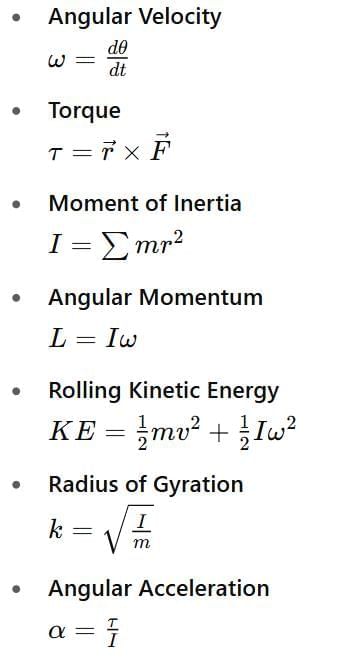How to Study Rotational Motion for NEET | Physics Class 11 PDF Download
Introduction
Rotational Motion is a crucial chapter in the NEET Physics syllabus, essential for securing a competitive edge in the exam. This topic, which deals with the behavior of spinning objects, regularly appears in the Physics section with about 2 to 4 questions (worth 4–8 marks).
Based on a thorough analysis of past NEET Question Papers, this guide provides a well-structured study plan that focuses on the most frequently asked areas with clear strategies and practical exam-day tips.

Understanding NEET Rotational Motion Syllabus
The Rotational Motion includes the following topics
- Angular Kinematics
- Moment of Inertia
- Torque
- Angular momentum
- Conservation Principles
- Rolling Motion
- Rotational Equilibrium
- Radius of Gyration
- Angular Acceleration
- Kinetic energy of Rotation
Focus on Core Concepts
As we have segregated the topics that are in the NEET Rotational Motion syllabus, let us focus on the most frequently asked topics for targeted and high-yield preparation
The chart at the beginning illustrates the frequency of Rotational Motion topics in NEET exams from 2016 to 2025.

- Moment of Inertia (8 questions): Rods, Spheres, Cylinders, Rings, and Gyration calculations.
- Torque (7 questions): Equilibrium, Angular Acceleration, and Force Applications.
- Radius of Gyration (4 questions): Linked to Moment of Inertia for various shapes.
- Rolling Motion (4 questions): Kinetic energy and velocity analysis in pure rolling.
- Angular Momentum (3 questions): Conservation and direct calculations.
- Angular Acceleration (2 questions): Related to Torque and Rotational dynamics.
- Kinetic Energy of Rotation (2 questions): Energy in Rotating Systems.
Syllabus Prioritization
On the basis of the graph given above, following is the list of most to least priority topics from the chapter Rotational Motion.
- High Priority (70% focus): Moment of Inertia, Torque, Radius of Gyration, Rolling Motion
- Moderate Priority (40% focus): Angular Momentum, Angular Acceleration
- Low Priority (20% focus): Rotational Equilibrium, Angular Kinematics, Kinetic Energy of Rotation
How to Study Important Topics
Now that we’ve nailed down the key topics, let’s map out our study plan—figure out which subtopics to start with, decide on the best ways to tackle each, and pick the go-to resources on which we’ll rely.
1. Moment of Inertia
- Focus: Master formulas for rods, spheres, cylinders, and rings, and understand the Parallel Axis Theorem and the Perpendicular Axis Theorem, which are frequently tested for calculating the Moment of Inertia of composite bodies.
- Method: Solve 10–15 problems daily on different shapes (e.g., hollow vs. solid spheres) and practice radius of gyration calculations.
2. Torque
- Focus: Understand τ = r × F and its role in Angular Acceleration (α = τ/I) and Rotational Equilibrium (net torque = 0), commonly tested in rod and flywheel problems.
- Method: Solve 5–10 problems daily on equilibrium (e.g., rods on walls) and torque-induced angular acceleration, focusing on vector cross products.
3. Radius of Gyration
- Focus: Relate k = √(I/m) to Moment of Inertia for various bodies, often tested with Moment of Inertia formulas for discs and spheres.
- Method: Practice 5–10 derivations and problems daily, comparing solid and hollow spheres, and use past NEET questions for context.
4. Rolling Motion
- Focus: Grasp kinetic energy (KE = (1/2)mv² + (1/2)Iω²) and velocity relationships (v = ωR) for pure rolling, frequently tested in disc and sphere scenarios.
- Method: Practice 5–10 problems daily on rolling without slipping, analyze examples like bullock cart wheels, and visualize motion using diagrams.
Resources for Important Topics
Core Materials: NCERT Physics Class 11 (Chapter 7: System of Particles and Rotational Motion), HC Verma's Concepts of Physics (Rotational Mechanics), DC Pandey's Objective Physics for NEET.
Memorize and Understand Formulas
Now that we have a clear plan, we can dive into learning and applying the essential formulas.

Numerical Practice
- Daily Objective: Solve 20–30 numerical problems daily, prioritizing high-frequency topics: moment of inertia, torque, radius of gyration, and rolling motion.
- Problem Sources: DC Pandey's Objective Physics, past NEET question papers, and EduRev app question banks.
- Focus Areas: Moment of inertia calculations, torque applications, rolling motion dynamics, radius of gyration derivations, and angular acceleration problems.
- Strategy:Time practice sessions to 1–2 minutes per question and maintain an error log to address recurring mistakes.
Solve Previous Years Papers
- Purpose: Review Physics papers focusing on moment of inertia (e.g., spheres, rods), torque (e.g., flywheel), and rolling motion (e.g., bullock cart wheel).
- Question Distribution: Expect 2–4 questions, with a strong likelihood of moment of inertia and torque problems.
Practice with Mock Tests
- Simulation: Take timed Mock Tests to replicate exam conditions.
- Focus: Improve time management and accuracy. Review mistakes to identify weak areas.
Exam Day Tips
Quick Formula Review: Before the exam, glance at your formula sheet for moment of inertia, torque, and rolling motion to reinforce key equations.
Prioritize High-Weightage Questions: Start with moment of inertia and torque questions, as they are more likely to appear and often straightforward if formulas are clear.
Prioritize Easy Questions: Start with straightforward questions to secure quick marks.
Check Units and Calculations: Ensure units are consistent (e.g., kg·m² for moment of inertia) and double-check multi-step calculations, especially for rolling motion.
Stay Calm: If stuck on a torque or equilibrium problem, take a deep breath and break it into smaller steps (e.g., draw force diagrams).
Additional Preparation Strategies
Consistency: Maintain a daily commitment of 2 hours to Rotational Motion for steady progress.
Precision: Verify calculations in multi-step numericals (e.g., rolling motion, moment of inertia) to minimize errors.
Time Management: Allocate 1–2 minutes per question initially, revisiting complex problems as needed.
Well-being: Prioritize 6–8 hours of sleep, incorporate 5-minute breaks hourly, and maintain a balanced diet to support focus and stamina.
Motivation: Set achievable short-term goals (e.g., mastering moment of inertia) and acknowledge progress to sustain momentum.
This structured guide, grounded in NEET trends and enriched with targeted strategies, is your ultimate roadmap to conquer Rotational Motion. Focus on moment of inertia, torque, radius of gyration, and rolling motion to maximize your Physics score.
Best wishes for your NEET preparation!
|
96 videos|367 docs|98 tests
|
FAQs on How to Study Rotational Motion for NEET - Physics Class 11
| 1. What are the core concepts of rotational motion that are essential for NEET preparation? |  |
| 2. How can I effectively memorize and understand formulas related to rotational motion? |  |
| 3. What strategies should I use for studying important topics in rotational motion for NEET? |  |
| 4. How important is numerical practice in mastering rotational motion for NEET? |  |
| 5. What are some effective tips for exam day when tackling rotational motion questions in NEET? |  |





















